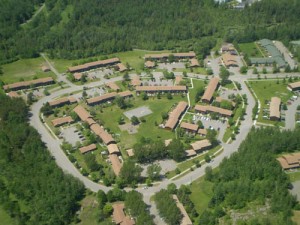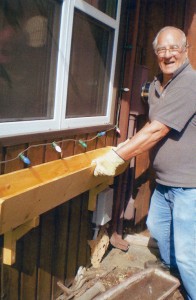How It All Began: Castlegreen Answers a Community Need
| Castlegreen began as every cooperative has ever begun: to answer a need in the community. In the Thunder Bay area in 1972, decent affordable housing was in short supply–this is still the case in 2002, but at least Thunder Bay has three housing cooperatives to help answer that need. Castlegreen was the first of many such co-ops in Ontario and among the first in Canada! But back to the ’70s. During the winter of 1972, the Lakehead Social Planning Council conceived the idea of a housing cooperative for Thunder Bay area, a radical notion at the time, but one with which the governments of the day were willing to assist. Among others, Prue Morton, Colleen Miller, Allen Nelson and Harvey Linetski called a public meeting at City Hall to circulate the idea around interested people in the Lakehead. |  |
| If we Build It…
At the meeting Glenn Haddrell, Executive Director of the Co-op Housing Federation of Canada and Central Mortgage and Housing Corporation consultant Dr Alex Laidlaw addressed the public. Dr Laidlaw in particular reflected the federal government’s willingness at the time to help grassroots movements address the shortage of affordable housing in Canada’s communities. All cooperatives start with a group of people who organize and work toward a goal. The Thunder Bay Cooperative Housing Association was the group that emerged from the sixty or so people who attended that founding meeting in 1973. With directors elected and a $2 membership fee per person to cover expenses, the Association set about the daunting task of finding land on which to build and capital to make it all possible. Right away, the committee itself had a need for a full-time coordinator, due to the immensity of the task before it. Allen Nelson was hired in this capacity with the help of another federal government initiative, the Company of Young Canadians. Although CMHC provided start-up funding ($9600), money came from two other important sources: Bishop Norman Gallagher lent the cooperative $2000 in an unsecured loan, while the United Church of Canada loaned $40,000 on similar terms. The momentum was building…. |
 |
| What’s In a Name?
Early on, the Association chose a name for the new cooperative project: CASTLEGREEN. “Castle” is an acronym or word made up of initials, standing in this case for Caring And Sharing To Live Economically. “Green” was added as a whole word to symbolize the Co-op’s determination to live environmentally responsibly, and to symbolize growth and renewal. Now the co-op had a name, the question was where will we build this community? Give me land, lots of land, and the starry skies above Another federal body, the Local Initiatives Programs, provided a grant for the Co-op to hire researches and community organizers, with organizational help from the Department of the Secretary of State. Castlegreen Cooperative set up shop in a drafty old house at 333 John Street, and was incorporated in early 1974. A housing co-op without land is a co-op in name only. The City agreed to a sixty-year lease (expires 2056) of some 11 acres of property between highway 17/11 and Wardrope Avenue, part of which had been a farm for a number of years. Soil tests were accomplished to help the choice of building sites, and the fledgling Co-op secured the services of Graham, Bacon and Welter to design the actual housing units. World-renowned architect Raymond Moryama came on board as consultant to the project. Housing Co-ops literally come in all shapes and sizes to meet differing needs: the Castlegreen committee members held planning meetings and seminars on house design and site planning, eventually coming up with the clustered town house design that makes up Castlegreen’s unique appearance. Before they could build, they had to move, shifting the Co-op’s offices to Simpson Street in the South Ward (formerly Fort William), and hiring Uniram Consulting as Construction Managers. Importantly, the Co-op itself would act as its own general contractor. As plans were submitted to subcontractors for tendering, the Co-op held its first ever annual meeting in September of 1974. Once tenders were in, Castlegreen was in a position to submit the project to CHMC for approval. In February of the following year, CMHC gave the go-ahead for 117 units in the first phase of building, providing a mortgage of $6.75 million: Castlegreen has always made its mortgage payments on time throughout its history. |
|
| The Winter of our (Dis)Content
The first sod was broken to begin construction in an emotional ceremony in October, 1975. In those days, the “loop” of Castlegreen’s main road was a single-lane gravel affair, and much of the area was covered with second-growth jackpine and poplar trees. In this beautiful location, the first units were set to be built–then winter struck. Winters on Lake Superior are always matters of conversation and occasionally of dread. The winter of 1975-76, when construction began, was one of those winters remembered for decades, as temperatures plunged to -40°C while heavy snowfalls broke past records. Heating and other costs strained our limited budget and slowed construction, but by June of 1976, after many setbacks, the first units were occupied in the 600 cluster. Not that everything was exactly shipshape: there was no electricity hooked up as yet and front steps were missing, to name but two deficiencies, but Castlegreen’s first units were occupied! In September, CMHC approved the next phase of construction, of 44 more units. In October, more than 400 guests attended Castlegreen’s grand opening celebration, which featured among other things an outdoor barbecue of a whole pig and a beef hind quarter: a good time was had by all except the pig and cow. Unfortunately, the upbeat mood of the day was not to last. |
 |
 |
|
